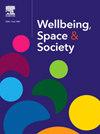The contribution of residential situations to mental health during COVID-19: A longitudinal survey
IF 2.2
Q2 GEOGRAPHY
引用次数: 0
Abstract
During the early stages of the COVID-19 pandemic, extended periods of confinement made housing the focal point of daily life. While the impact of sanitary health measures on mental health has been extensively studied, the role of housing remains less understood. Our literature review indicates that housing characteristics and usage patterns influenced mental health outcomes during the pandemic. This study aims to test the hypothesis that the concept of residential situation –an original framework integrating housing attributes, individual and household characteristics, and occupational profiles– is associated with stress, wellbeing, depression, and anxiety measures. We employed data mining techniques and ordinal logistic regression models on a sample of 781 participants from a longitudinal survey conducted in Québec, Canada, between April 2020 and May 2021. Our findings reveal that higher dwelling occupation density is positively associated with increased stress levels. Additionally, apartment living, after adjusting for the number of children under the age of nine, shows a significant association with stress. Feelings of depression and low wellbeing are linked with experiencing separation from loved ones. Also, depression, wellbeing, and anxiety measures were found to be strongly associated with income. This study underscores the effectiveness of a comprehensive framework, applying the interdisciplinary concept of residential situations to capture the nuanced impact of housing on mental health through its links to family dynamics, and shows the importance of social class membership for mental health during crises.
COVID-19期间居住状况对心理健康的影响:一项纵向调查
在COVID-19大流行的早期阶段,长时间的隔离使住房成为日常生活的焦点。虽然卫生保健措施对心理健康的影响已得到广泛研究,但对住房的作用仍知之甚少。我们的文献综述表明,住房特征和使用模式影响了大流行期间的心理健康结果。本研究旨在验证以下假设:居住状况的概念——一个整合住房属性、个人和家庭特征以及职业概况的原始框架——与压力、幸福感、抑郁和焦虑措施有关。我们在2020年4月至2021年5月期间在加拿大qu忧郁进行的纵向调查中,对781名参与者的样本采用了数据挖掘技术和有序逻辑回归模型。我们的研究结果表明,较高的居住密度与压力水平的增加呈正相关。此外,在调整了9岁以下儿童的数量后,公寓生活与压力有显著关联。抑郁和低幸福感与与亲人分离的经历有关。此外,研究还发现,抑郁、幸福感和焦虑程度与收入密切相关。本研究强调了综合框架的有效性,运用跨学科的居住情况概念,通过住房与家庭动态的联系,捕捉住房对心理健康的细微影响,并显示了危机期间社会阶层成员对心理健康的重要性。
本文章由计算机程序翻译,如有差异,请以英文原文为准。
求助全文
约1分钟内获得全文
求助全文
来源期刊

Wellbeing Space and Society
Social Sciences-Social Sciences (miscellaneous)
CiteScore
2.70
自引率
0.00%
发文量
46
审稿时长
124 days
 求助内容:
求助内容: 应助结果提醒方式:
应助结果提醒方式:


